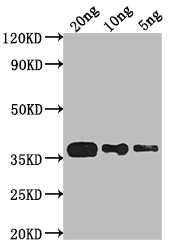The production of the phoP polyclonal antibody involves a methodical approach. It starts with the repeated immunization of a rabbit using recombinant Escherichia coli transcriptional regulatory protein phoP (1-223aa), continuing until the desired antibody titer is achieved. Following this, the rabbit's blood is collected, and the antibodies are carefully purified from the serum using protein A/G. The resulting phoP antibody undergoes rigorous evaluation through ELISA and WB applications, confirming its specific reactivity with the Escherichia coli phoP protein.
Escherichia coli phoP acts as a transcriptional regulator that controls the expression of genes involved in phosphate sensing, uptake, and utilization. Its primary role is to help the bacterium adapt to changes in phosphate availability in its environment and to ensure that it can efficiently acquire and utilize phosphate for various cellular processes.







